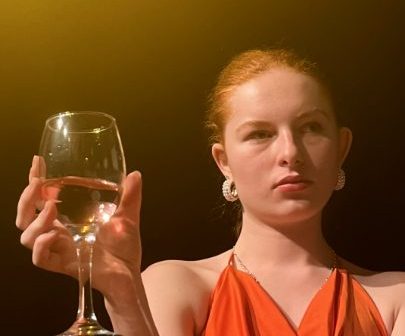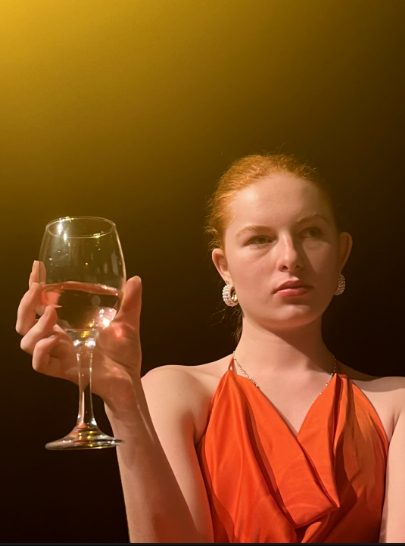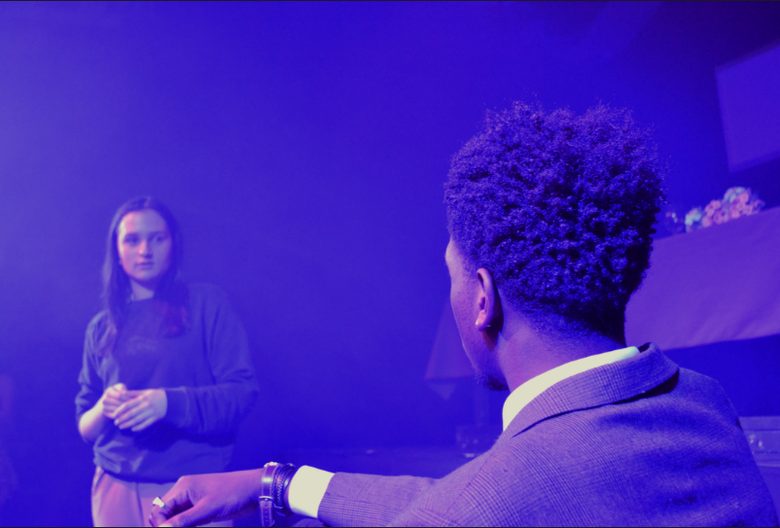A rich and fruity show can satisfy those with even the most demanding pallets
Theatre Group’s Dinner is a darkly funny show with twists, turns, and several plastic lobsters. An excellent cast show great dramatic discipline in bringing such a complex plot to life and keeping the audience laughing throughout.
Dinners have always been a great narrative way for drama to happen – whether it’s Macbeth seeing the dead or “The Rains of Castamere” suddenly being played at a wedding feast, something is probably going to go wrong. This is such a naturally-occurring part of drama that some productions have predicated their entire premise to what goes on around a dinner table, from sitcoms and theatre shows to reality TV.
Moira Buffini’s addition to this list was brought to stage for the first time in 2002 and was run again in the West End in 2003. It had a strong cast, including Harriet Walter, Nicholas Farrell and Adrian Rawlins. Directed by Moira’s sister, Fiona Buffini, the show’s inception generated generally alright reviews. While it was praised for its ‘poisonous stylishness’ and ‘fun’, it was also called ‘dramatically underdeveloped’ and ‘less than the sum of its parts’. While I’m not going to tuck in to the play itself and write a textual analysis of the script, I do wonder if these same criticisms would have been levied at TG’s summer production, who deal with this undeniably rich-yet-sharp play in a characteristically delicious and beautifully well balanced fashion. All of the reviews I’ve read of the original show are of course littered with meal-based puns, and while, I admit, I am indulging myself just a little on this front, delicious is actually quite a good word to describe this flavourful production.
Ah, you see, the problem here is that I quite like food-based metaphors anyway, so I’m left in a bit of a pickle as I try to avoid them.
It’s not Willy Wonka’s chocolate factory, so the stage isn’t edible, but it was well thought out nonetheless. Naturally, a dinner table had to be brought to stage. To avoid the issue of audience members craning their necks to see the action unfold, the table was placed on a raised section upstage. This also nicely split the stage in two, allowing the downstage area to be the miscellaneous not-dining-room area. The only issue here was that when the drama fell to the floor (literally) in the downstage area, it was difficult for the audience to see quite what was going on. The two layers of stage allowed for some interesting blocking and gave the dinner table a sickly performative feeling as Paige’s plans unfold. Lottie Klafkowska opens the play as Paige conferring with the bafflingly mysterious and alluringly assured “Waiter”, who spends nearly the rest of the play standing in the background with a knowledgeable dignity. Lottie brought an impressive, almost oxymoronic blend of confidence and stress to Paige as she waited for the guests to arrive at her grand dinner party. The show spends no time pretending the eponymous dinner is going to be a normal one, and lathers a lasagne worth of layers of intrigue onto the plot very quickly indeed. Paige’s wife, Mel Ensert’s Lars, acts as a foil to the prestige that Paige pours on herself and her dinner. She looks rather fed up with the affair as we are introduced to their obviously unhappy marriage at the beginning, and their contrasting costumes tell a clever story. Not only does the difference between Lars’ casual clothes and Paige’s more extravagant dress suggest a difference between the eminence they wish to place on the occasion, but it reveals how they wish to be seen as well. Paige stands with false class and confidence, while Lars tries to outwardly convey a content, casual mindset free of worry. These traits bled more and more through the performances as both Lottie and Mel simmered away and revealed more about the depths of their characters as the show progressed.
Estelle Olcott’s Wynne was the first guest to arrive, and added some much needed joy to the chilly couple that waited for her. Estelle gave a fantastic energy to Wynne, and her overly positive (and sometimes comedically naive) characterisation made her a joy to watch on stage. This passionate and well meaning personality was delivered with every word. Even in the show’s darker moments, Estelle could well balance the comedy of her character, and the emotions behind the laughs as well. She was soon joined by Belle Priestley’s Sian and Richard Orebela’s Hal, adding another troubled married couple to the mix. Yet more tensions were drawn up and with all the guests seemingly present, the actual dinner began. It was when (nearly) everyone was together that the play really came alive. They worked incredibly well as a unit, bouncing their lines and reactions off each other and their characters, and despite the limited physical onstage action (given they were all sitting at the dinner table), it was thoroughly entertaining seeing these characters deal with the rising tensions of the meal. Or, naturally, increasing the tensions themselves. What was particularly crucial to the play working as a whole was their ability to evolve in tandem as well. As their character arcs progressed and their characters got more annoyed/drunk/other, they continued to compliment each other’s performances. I’ll get on to more specific examples of that later during the most dramatic moments. This unity is truer still after the introduction of the final ‘unexpected’ guest, Eden Jack’s Mike. When Eden walked on stage and announced that he had been involved in an accident and needed to borrow a phone, I was fairly close to running on stage and handing him my own. He was excellent at bringing a sense, at least to begin with, of an ‘everyman’ to this cast of strange characters. The uncomfortable, realistic reaction of his character at his introduction to the goings-on at Lars/Paige’s dinner heightened the comedy further.
When Mike sat down at the table, it felt like the last piece of the puzzle had been placed. Not least because there had been an empty chair before, and that was almost as uncomfortable as an unfinished puzzle. This brings me to one of the production’s greatest strengths. Each character on stage told a story at all times, whether they were talking, listening, eating, or even just standing in the background looking intriguingly mysterious. This is a mark of truly good theatre, especially with such an ensemble-like cast, where everyone has their own story to tell. Sometimes, a character’s reaction could tell you more about themselves, and at other times it could even hint at the larger twists that were yet to take place. This may sound particularly difficult to digest, but the cast never took too much attention away from what the audience was supposed to be focussed on. Under the directors’ guidance, they managed the focus of the action impressively. One review of the original 2002 production praised the level of acting talent for being able to deliver such a complex play and keep it from being too overwhelming to the audience, and the same is true for Theatre Group’s 2024 production. That is not to eschew praising the work of everyone else in the production, but I shall cover that a little later.
This is, I imagine, somewhat of a subjective opinion, but my favourite moments of Hal were when he was at his most clueless. Richard accentuated these moments of fumbling panic in a way I imagine most actors wouldn’t dare attempt, but he pulled it off hilariously. My favourite example of this was when Mike was pretending to have robbed a neighbour’s house, and clearly having fun with the idea. He jokingly suggested he should go back later, to which Hal responded by panickedly grabbing Mike and telling him he must ‘never return to the scene of the crime’. This tickled me immensely. Hal’s wife Sian was a very different character. It is clear when Mike arrives that she is the most publicly recognisable character at the table, and she slowly tones down her previously icy composure when Mike gives her the attention, and perhaps respect, she had not received before. At the beginning, Sian is tart, sarcastic, and generally unpleasant. She’s certainly not alone in this, but Belle brought such a sharpness to her that even the audience were unnerved. But throughout the play, she slowly unfolds and reveals a deeper complexity to her. While her zesty sarcasm never leaves her, the audience is allowed to see how isolated she has felt, especially while harbouring the grand secret of her pregnancy from her husband.
It was a fair way into the second act when the comedic tropes that had been laid down started to unravel into something more sinister entirely, and Paige’s grand plan was slowly revealed. The whipped up tension was spread evenly across the audience, as the jokes that remained were met with almost thankful laughter. Wynne and Hal especially kept their comedic lightness, not allowing the flavours of the all-too-serious topics suddenly under discussion to overpower the audience. Wynne’s enthusiastic answers to the question of ‘what could you list as a murder weapon’ drew out well deserved rapturous laughter from the audience. Both these characters were still just as three dimensional as those that (mostly) were no longer making us laugh, and joined the rest of the cast in adapting to the dark stakes that they had to face. Perhaps this was best shown off at the moment The Waiter revealed herself and the silent but powerful dignity was explained. A gun was drawn, and Paige went around and asked if the guests wanted coffee. Their responses were hilarious, snappy, and a great one-line-tour of their characters.
Some of the characters were able to show yet more of themselves in these final moments. Mel acted terrifyingly nonchalant about much of the affair, and brought an expertly subtle cruelty and unpleasantness to Lars. The confidence Mike had in the face of danger was enticing and Hal’s panic was at its most hilarious. Belle brought more humanity without taking characteristics away from Sian, and Wynne maintained her enthusiastic uselessness as Estelle continued to pour energy into her. Lottie’s most impressive moments as Paige were in the closing stages of the second act. Much of the heavy lifting when it came to raising the tension was done by her increasingly blase (and, I rather think, drunk) attitude towards her guests. It felt dangerous and weighted, and during the emotional reveal of where this bitterness was coming from, Lottie gave a cutting performance that did not fall into the trap of being overdone.
The lighting in these final scenes was particularly fun, as StageSoc, who managed the technical side of the performance under the guide of technical directors Simon, Rubens and Si, were able to flex their capabilities a bit more. The characters and courses had been introduced with text illuminating empty picture frames at the back of the stage, but my personal favourite use of lighting was the flickering chandelier above Paige at her most vulnerable and tumultuous moment. It was effective and yet not as distracting as a simple strobe, allowing the focus to be on Paige.
The success of directors Saskia Bindloss and Kat Fevyer in pulling this all together ought not to be overlooked. When I spoke to members of the tech crew, they were keen to praise the creative ideas that the directors had as the technical side of things were set up. Speaking to the actors, they were just as keen to tell me that the rehearsal process was rigorous and thoroughly enjoyable, and the whole cast felt very comfortable in their characters. Dinner simply would not have worked had the dialogue been slow or sloppy, so it was clear that Saskia and Kat had worked hard on making sure the lines were snappy and fast but well paced.
Lots of elements came together and made a rather complex show a joy to watch. The production stood solid as a whole, and that helped it flow through the narrative and comedic beats of the script that so baffled critics twenty two years ago.






